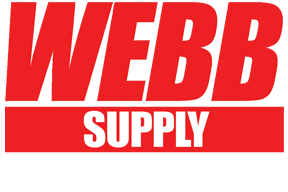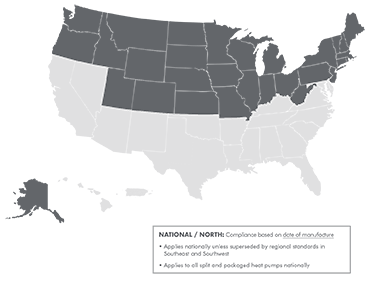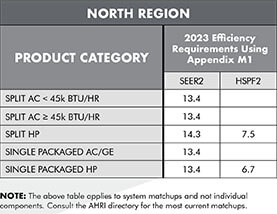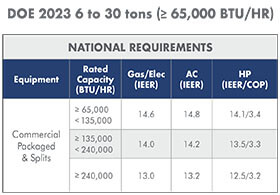
COLUMBUS, Ohio, June 21, 2023– On Tuesday, June 20, 2023, the U.S. Court of Appeals for the District of Columbia Circuit ruled in favor of Heating Air-conditioning & Refrigeration Distributors International (HARDI) et al. by striking down provisions of the Environmental Protection Agency’s (EPA) allocation rule that would ban the use of non-refillable cylinders and require QR code tracking of refrigerant cylinders.
In 2020, the EPA was directed under the American Innovation and Manufacturing Act (AIM Act) to phase down the production and import of hydrofluorocarbons (HFCs), which are chemical compounds typically used as refrigerants in air-conditioning and refrigeration. Since it was first enacted, HARDI and the rest of the HVACR industry supported the AIM Act and continue to support the HFC phase-down and the rulemaking process EPA uses to implement it.
In 2021, as a response to the directive, EPA proposed the Phasedown Rule. Among other provisions, the rule included aproposed ban on non-refillable cylinders and required QR code tracking for individual cylinders.
Three trade associations, HARDI, Air Conditioning Contractors of America (ACCA), and Plumbing-Heating-Cooling Contractors (PHCC), along with Worthington Industries, a domestic manufacturer of refillable and disposable cylinders, filed petitions against EPA challenging the non-refillable cylinder ban and the requirement to track individual cylinders through the supply chain. On Tuesday, the court agreed with these challenges, and the EPA has been ordered to vacate these portions of the allocation rule. The EPA is allowed to appeal the decision.
A third challenge to the allocation rule, filed by a separate petitioner, would have eliminated the need for allocations to import HFC blends. This challenge was rejected by the courts, a decision that HARDI supports.
HARDI CEO Talbot Gee celebrated the decision, saying, “This confirms HARDI’s role in protecting wholesale distribution. Since 2021 when the rule was first proposed, we have sought feedback from our members about these provisions, and overwhelmingly, our membership rejected the need for refillable cylinders and a complex tracking system. HARDI has had a positive, multi-decade relationship with the EPA, and now we look forward to continuing to work with them on the successful implementation of the AIM Act.”
HARDI, ACCA, and PHCC were represented by Jonathan Martel, Ethan Shenkman, and Stephen Wirth of Arnold & Porter. The lawsuit argued that EPA lacked the legal authority to implement the refillable cylinder and QR-code rules. In the final decision, Judge Justin Walker noted, “We agree. The EPA has not identified a provision of the AIM Act giving it the authority to require refillable cylinders or a QR-code tracking system.”
EPA argued that the rules were necessary to prevent illegal imports of HFCs, and the agency could derive authority from the phrase “shall ensure” existing in the statute. However, the EPA has already demonstrated that the QR code tracking mandate and non-refillable cylinder ban are unnecessary to interdict illegal imports of HFCs. In 2022, in partnership with Customs and Border Patrol, EPA stopped HFCs equaling 889,000 metric tons of GWP from entering the country without the tracking or cylinder provisions in place. EPA is already well equipped to stop illegal imports without operationally burdening the entire HVACR supply chain.
HARDI’s Director of Government Affairs, Alex Ayers, commented, “Since the passage of the AIM Act in 2020, the EPA has been diligently working to get the regulations in place for our industry to phase down the use of HFCs, but with the speed of these regulations comes bad ideas that will damage our members. We continue to fight back with all of our available resources to stop these bad ideas from being implemented. HARDI is happy to see the court agree that the EPA exceeded its authority in banning non-refillable cylinders and requiring the tracking of every cylinder used at consumers’ homes and businesses. HARDI and the entire HVACR industry remain supportive of the HFC phase down, and we look forward to continuing to work with the EPA in achieving the goals of the AIM Act.”
HARDI acknowledges that the outcome was made possible primarily due to the support of its Legal Defense Fund.“ While it’s unfortunate to need a legal defense fund, it’s a testament to the association’s leadership, members, and team that HARDI can fund such important protections of our members’ interests,” explained Rhonda Wight, Chairwoman of the HARDI Board of Directors and President and CEO of Refrigeration Sales Corp. “The HARDI legal team did an exceptional job arguing the importance of federal agencies remaining within the bounds of the authorities granted to them by Congress. ”
The association is continually grateful to its members and the HVACR community for its support of the fund, its support of the association, and for backing its advocacy programs.
ABOUT HARDI
HARDI (Heating, Air-conditioning and Refrigeration Distributors International) is the single voice of wholesale distribution within the North American and Latin American HVACR markets.
A non-profit association, HARDI serves its members through government affairs and advocacy efforts, market intelligence and benchmarking, training programs, and world-class events. HARDI proudly represents more than 460 distributor members and their 5,000 + branch locations, and close to 500 suppliers, manufacturer representatives, and service vendors. HARDI Distributor members serve installation and service/replacement contractors in residential and commercial markets, as well as commercial/industrial and institutional maintenance staffs. HARDI Affiliate members market, distribute, and support heating, air-conditioning, and refrigeration equipment, parts and supplies. Learn more at www.hardinet.org.





